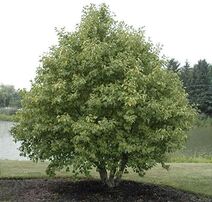Alnus rugosa
| Alnus rugosa | |
 | |
| Light: | |
| Moisture: | |
| Hardiness: | 2 |
| Soil pH: | 5.6-8.4 |
| Height: | 72' |
| Speed: | Fast |
| Blooms: | Late Spring |
| Open Woods Forest | |
| Native to: | |
| Nitrogen Fixer | |
| Medicinal Rating: | |
| Tea: | Yes |
Alnus rugosa (common name: speckled alder) is a fast-growing but short-lived tree[1] used locally for fuel but the wood has no commercial value. Because root nodules of alders support nitrogen-fixing bacteria, yields of timber-producing trees can be enhanced when grown in association with alder, in the same way that leguminous crops increase production in agricultural crops. The nitrogen-enhancing effect is local and restricted to trees in the immediate vicinity of the alder. Rapid growth in open habitats, wide tolerance to soil types, and potential for soil conditioning make it useful in rehabilitation of disturbed sites, including old mines.[2]
Alders can easily be trained to a tree-like form by removing lower branches.[2]
Propagation: Seed - best sown in a cold frame as soon as it is ripe and only just covered[3]. Spring sown seed should also germinate successfully so long as it is not covered[3][K]. The seed should germinate in the spring as the weather warms up. When large enough to handle, prick the seedlings out into individual pots. If growth is sufficient, it is possible to plant them out into their permanent positions in the summer, otherwise keep them in pots outdoors and plant them out in the spring.
If you have sufficient quantity of seed, it can be sown thinly in an outdoor seed bed in the spring[4]. The seedlings can either be planted out into their permanent positions in the autumn/winter, or they can be allowed to grow on in the seed bed for a further season before planting them.
Cuttings of mature wood, taken as soon as the leaves fall in autumn, outdoors in sandy soil.
Cultivation: Prefers a heavy soil and a damp situation[5][6]. Grows well in heavy clay soils[6]. Tolerates very infertile sites[3].
Closely related to A. incana[6] and considered to be no more than a sub-species (A. incana rugosa) by some botanists.[7]
This species has a symbiotic relationship with certain soil micro-organisms, these form nodules on the roots of the plants and fix atmospheric nitrogen. Some of this nitrogen is utilized by the growing plant but some can also be used by other plants growing nearby[3].
Range: Northern and Eastern N. America - Hudson's Bay to Virginia. Naturalized in C. Europe[8].
Habitat: Wet sandy or gravelly soils, usually along streams and rivers, but also in ponds and swamps[1]. It is only found in open sunny areas, being unable to compete in dense shade[1].
Medicinal: The speckled alder was quite widely used medicinally by the native North American Indians who used it to treat a variety of complaints[9]. It is little used in modern herbalism.
The bark is alterative, astringent, emetic, laxative, ophthalmic, stomachic and tonic[10][11][9]. The bark contains salicin[7], which probably decomposes into salicylic acid (closely related to aspirin) in the human body[12]. This is used as an anodyne and febrifuge.[7] The root bark was mixed with molasses and used in the treatment of toothache[9]. A decoction of the inner bark was used as a wash for sore eyes.[9]
The outer bark is an astringent and is applied as a poultice to bleeding wounds, it also reduces swellings.[7]
Usage: This is an excellent pioneer species for re-establishing woodlands on disused farmland, difficult sites etc[7]. Its fast rate of growth means that it quickly provides sheltered conditions to allow more permanent woodland trees to become established. In addition, bacteria on the roots fix atmospheric nitrogen - whilst this enables the tree to grow well in quite poor soils it also makes some of this nitrogen available to other plants growing nearby. Alder trees also have a heavy leaf canopy and when the leaves fall in the autumn they help to build up the humus content of the soil. Alder seedlings do not compete well in shady woodland conditions and so this species gradually dies out as the other trees become established[K].
The tree has an extensive root system and can be planted to control banks from erosion[7].
A dark dye is obtained from the bark[7]. Browns, through red to orange colours can be obtained from the bark[9].
The wood is soft, weighing 29lb per cubic foot[13]. The tree is too small to be of importance for lumber or fuel[1].
Pollinators: Wind
Soil: Can grow in medium and heavy soils.
Seed Ripens: Mid Fall
Flower Type: Monoecious
Heavy Clay: Grows in heavy-clay soils.
Also Known As: A. incana rugosa. (Duroi.)Clausen.
Links
- Alnus rugosa - Plants for a Future
- Speckled Alder - USDA Plant Guide
References
- ↑ 1.0 1.1 1.2 1.3 Elias, Thomas. The Complete Trees of North America. Van Nostrand Reinhold, 1980.
- ↑ 2.0 2.1 https://plants.usda.gov/plantguide/pdf/cs_alinr.pdf
- ↑ 3.0 3.1 3.2 3.3 Huxley, Anthony. The New Royal Horticultural Society Dictionary of Gardening. MacMillan Press, 1992.
- ↑ Sheat, Wilfrid. Propagation of Trees, Shrubs and Conifers. St Martin, 1948.
- ↑ Chittendon, Fred. RHS Dictionary of Plants. Oxford University Press, 1951.
- ↑ 6.0 6.1 6.2 Bean, William. Trees and Shrubs Hardy in Great Britain. Murray, 1981.
- ↑ 7.0 7.1 7.2 7.3 7.4 7.5 7.6 Lauriault, Jean. Identification Guide to the Trees of Canada. Fitzhenry and Whiteside, 1989.
- ↑ Tutin, Tom et al.. Flora Europaea. Cambridge University Press, 1964.
- ↑ 9.0 9.1 9.2 9.3 9.4 Moerman, Daniel. Native American Ethnobotany. Timber Press, 1998.
- ↑ Uphof, Johannes. Dictionary of Economic Plants. Weinheim, 1959.
- ↑ Usher, George. A Dictionary of Plants Used by Man. Constable, 1974.
- ↑ Weiner, Michael. Earth Medicine, Earth Food. Ballantine Books, 1980.
- ↑ Britton, Nathaniel and Addison Brown. An Illustrated Flora of the Northern United States and Canada. Dover Publications, 1970.